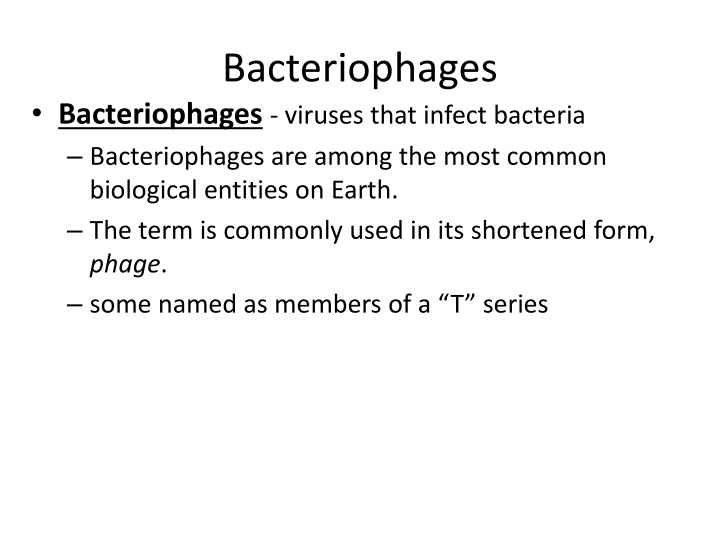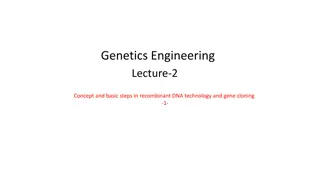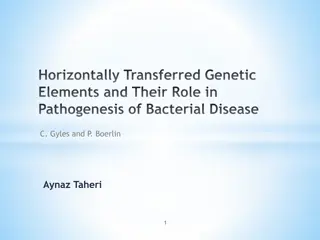
Bacteriophages: Viruses that Infect Bacteria
Discover the fascinating world of bacteriophages, viruses that infect bacteria. Learn about their structure, lifecycle, and potential therapeutic applications in combating multi-drug resistant strains. Explore the lytic and lysogenic cycles, and how these phages interact with host cells to reproduce and spread.
Download Presentation

Please find below an Image/Link to download the presentation.
The content on the website is provided AS IS for your information and personal use only. It may not be sold, licensed, or shared on other websites without obtaining consent from the author. If you encounter any issues during the download, it is possible that the publisher has removed the file from their server.
You are allowed to download the files provided on this website for personal or commercial use, subject to the condition that they are used lawfully. All files are the property of their respective owners.
The content on the website is provided AS IS for your information and personal use only. It may not be sold, licensed, or shared on other websites without obtaining consent from the author.
E N D
Presentation Transcript
Bacteriophages Bacteriophages - viruses that infect bacteria Bacteriophages are among the most common biological entities on Earth. The term is commonly used in its shortened form, phage. some named as members of a T series
Bacteriophages One of the densest natural sources for phages and other viruses is sea water, where up to 9 108virions per milliliter have been found in microbial mats at the surface, and up to 70% of marine bacteria may be infected by phages. They have been used for over 60 years as an alternative to antibiotics in the former Soviet Union and Eastern Europe. They are seen as a possible therapy against multi drug resistant strains of many bacteria.
Bacteriophages Structure Picture on left is a real SEM image
Bacteriophage infections Bacteriophages, just like other viruses, must infect a host cell in order to reproduce. The steps that make up the infection process are collectively called the lifecycle of the phage. Some phages can only reproduce via a lytic lifecycle, in which they burst and kill their host cells. Other phages can alternate between a lytic lifecycle and a lysogenic lifecycle, in which they don't kill the host cell (and are instead copied along with the host DNA each time the cell divides). Let's take closer look at these two cycles. As an example, we'll use a phage called lambda), which infects E. coli bacteria and can switch between the lytic and lysogenic cycles.
Lytic Cycle In the lytic cycle, a phage acts like a typical virus: it hijacks its host cell and uses the cell's resources to make lots of new phages, causing the cell to lyse (burst) and die in the process.
Attachment: Proteins in the "tail" of the phage bind to a specific receptor (in this case, a sugar transporter) on the surface of the bacterial cell. Entry: The phage injects its double-stranded DNA genome into the cytoplasm of the bacterium. DNA copying and protein synthesis: Phage DNA is copied, and phage genes are expressed to make proteins, such as capsid proteins. Assembly of new phage: Capsids assemble from the capsid proteins and are stuffed with DNA to make lots of new phage particles. Lysis: Late in the lytic cycle, the phage expresses genes for proteins that poke holes in the plasma membrane and cell wall. The holes let water flow in, making the cell expand and burst like an overfilled water balloon. Cell bursting, or lysis, releases hundreds of new phages, which can find and infect other host cells nearby
Lysogenic cycle Does not immediately kill the cell integrate their nucleic acid into the genome of the infected host cell (prophage). prophage - phage genome inserted as part of the linear structure of the DNA chromosome of a bacterium The integration of a virus into a cellular genome is termed lysogeny.
Lysogenic cycle The lysogenic cycle allows a phage to reproduce without killing its host. Most phages are either purely lytic (sometimes called virulent phages) or capable of switching between the lytic and lysogenic cycles (sometimes called temperate phages). However, when it comes to virology, there is an exception to almost every rule, and this is true for phage lifecycles. Filamentous (long, rod-shaped) phages are secreted from the cell in a process that does not lyse or kill the cell (even though the cell is actively producing new phage particles) lifecycle that does not actually involve lysis. In the lysogenic cycle, the first two steps (attachment and DNA injection) occur just as they do for the lytic cycle. However, once the phage DNA is inside the cell, it is not immediately copied or expressed to make proteins. Instead, it recombines with a particular region of the bacterial chromosome. This causes the phage DNA to be integrated into the chromosome. Not all phages integrate their DNA into the genome of their host during the lysogenic cycle. Some instead keep their genome in the cell as a separate, circular piece of this is still considered a lysogenic cycle because the phage does not drive production of new virus particles or kill the cell.
Lysogenic cycle Attachment. Bacteriophage attaches to bacterial cell. Entry. Bacteriophage injects DNA into bacterial cell. Integration. Phage DNA recombines with bacterial chromosome and becomes integrated into the chromosome as a prophage. Cell division. Each time a cell containing a prophage divides, its daughter cells inherit the prophage.










